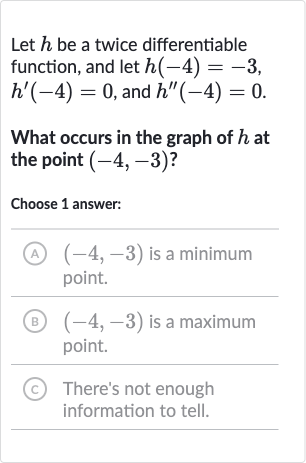Full solution
Q. Let be a twice differentiable function, and let , , and .What occurs in the graph of at the point ?Choose answer:(A) is a minimum point.(B) is a maximum point.(C) There's not enough information to tell.
- Given Information: We are given that is a twice differentiable function, and we have information about the function and its derivatives at the point . The value of the function at is , which tells us that the point lies on the graph of .
- First Derivative Analysis: The first derivative of at is given as . The first derivative represents the slope of the tangent line to the graph of the function at a particular point. Since , the tangent line to the graph of at is horizontal. This could indicate a local maximum, a local minimum, or a point of inflection.
- Second Derivative Analysis: The second derivative of at is given as . The second derivative provides information about the concavity of the function. If the second derivative is positive, the function is concave up (shaped like a cup), and if it is negative, the function is concave down (shaped like a cap). Since , we cannot determine the concavity of the function at from this information alone.
- Conclusion: Given that both the first and second derivatives of at are zero, we cannot conclusively determine whether is a minimum point, a maximum point, or neither. We would need additional information about the behavior of the function and its derivatives in the vicinity of to make a determination.
More problems from Power rule
QuestionGet tutor help
QuestionGet tutor help
QuestionGet tutor help
QuestionGet tutor help
QuestionGet tutor help
QuestionGet tutor help
QuestionGet tutor help
QuestionGet tutor help
QuestionGet tutor help

